The Wheelchair Guide
Your Wheelchair and Mobility Scooter Resource
Commercial Wheelchair Lifts
Tuesday, November 9th, 2010
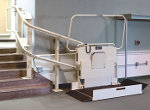 In the home, while building codes and inspections are required, there is generally a much more relaxed attitude towards the use of safety devices, such as wheelchair ramps or porch lifts, but in a commercial environment, there is a much stricter process of ensuring that these sorts of devices not only meet code, but also receive regular maintenance. For this reason, when someone wants to install a commercial wheelchair lift, there are a number of factors that must be considered.
In the home, while building codes and inspections are required, there is generally a much more relaxed attitude towards the use of safety devices, such as wheelchair ramps or porch lifts, but in a commercial environment, there is a much stricter process of ensuring that these sorts of devices not only meet code, but also receive regular maintenance. For this reason, when someone wants to install a commercial wheelchair lift, there are a number of factors that must be considered.
Porch lifts, which is a more colloquial term for vertical platform lifts, are in many ways very similar to an elevator. However, where an elevator requires a great deal of structure, namely the elevator shaft, a vertical platform lift is a single self contained unit. The main advantage of vertical platform lifts over elevators is that they can be placed next to a staircase, providing full access to the area, but with little actual modification to the existing structure of the building.
Meeting and Exceeding City Requirements
When considering installing a commercial wheelchair lift, however, the distinction between elevator and wheelchair lift is often a little less clear, as many cities and municipalities classify these devices as elevators, which must meet similar codes and requirements.
So, the first step for any business owner wishing to install a vertical platform lift, should always be to check city or county codes. A good place to start is to call up your local inspector, which is often located in town hall. If they do not know the codes that a wheelchair lift would fall under, they will be able to point you in the right direction. However, it is important to find and read the required code, with reference books often being available at the library.
A Word About Litigation, the ADA, and Basic Requirements
Making sure the wheelchair lift meets code is important not only for safety and inspection purposes, but also for reducing the risk of a lawsuit or injury. It is important to keep in mind that while in some cases, a vertical platform lift might bring a busi9ness up to code, such as if the business does not meet ADA standards and has no wheelchair ramp, it can also open the business owner up to litigation if there is an injury on the device or a malfunction.
There are several things that a business owner can do to mitigate these risks, such as using a commercially rated wheelchair lift that well exceeds the lifting requirements of the users. In addition to a larger lifting capacity, having a locking mechanism, so the wheelchair lift can only be operated by authorized personal is also very important.
It is also essential that a door is present at the top of the landing, so when the wheelchair lift is moving or at the bottom of the stairs, someone can not fall through the opening. Many commercial wheelchair lifts include a built in door, but it can also be added as an extension of the existing handrail.
Wheelchair Lifts vs Wheelchair Ramps
Thursday, September 9th, 2010
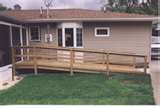 In homes that have a staircase on the front access, it can be very difficult for wheelchair users to safely and conveniently get into and out of their home. There are a number of options available to help make this task easier, but in most cases, the wheelchair lift is the most effective and safest type of home mobility aid.
In homes that have a staircase on the front access, it can be very difficult for wheelchair users to safely and conveniently get into and out of their home. There are a number of options available to help make this task easier, but in most cases, the wheelchair lift is the most effective and safest type of home mobility aid.
Wheelchair Ramps
Traditionally, wheelchair ramps have been used to allow full access to a home. These are commonly seen on commercial buildings and often on homes as well. For non-commercial use, the most common type of wheelchair ramp is the wooden one, which is made in a manner similar to building a deck. There are a number of wheelchair ramp plans available and most capable contractors or handymen can build one, with most areas having companies that also specialize in custom wheelchair ramps. Generally, if you would not feel comfortable building your own deck, it is not a good idea to build a wooden wheelchair ramp.
In addition to wooden ramps, there are a number of pre-made metal ramps. Some of these are simple metal planks or threshold ramps, which are mainly used when there is only a step or two that must be navigated. For larger staircases, modular metal ramps are available, which come in sections and can be fitted together very easily.
While wheelchair ramps, at least wooden wheelchair ramps, are usually a good deal less expensive than a wheelchair lift, they can take up a lot of space. In the case of wooden ramps or modular ramps, it is not common for a significant amount of the front yard to be taken up by the wheelchair ramp. Smaller ramps, which are used when there is just a step or two, can make regular use of the staircase more difficult.
Wheelchair Lifts
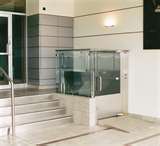 Wheelchair lifts are usually a more expensive option than building your own wooden wheelchair ramp, although modular -metal wheelchair ramps can get much more expensive and are often similar cost to a wheelchair lift. However, the added cost comes with a great deal more convenience and flexibility.
Wheelchair lifts are usually a more expensive option than building your own wooden wheelchair ramp, although modular -metal wheelchair ramps can get much more expensive and are often similar cost to a wheelchair lift. However, the added cost comes with a great deal more convenience and flexibility.
Wheelchair lifts, or vertical platform lifts, are basically a completely self-contained elevator unit, which is placed next to a staircase. Since the vertical platform lift is self-contained, there is no need to modify the home, such as you would need to do when building a residential elevator. Instead, the wheelchair lift can be placed directly next to the staircase and used to lift the user safely and quickly to the landing.
The biggest concern with an outdoor wheelchair lift is that the base that the unit sits on is well made and provides adequate drainage. A concrete base works best, although a wooden base can also be used, providing it is sturdy enough to support the weight of the vertical platform lift and its occupants.
It is also very important to consider things like overhanging branches, which could fall on the lift during a storm and damage it, as well as roof water run-off. In the case of the latter, it is very important that gutters are installed above the wheelchair lift and that ground water can not build up around the base of the device.
In addition to being easier to use, wheelchair lifts are installed on the side of a staircase, next to the landing. This means that full access to the steps will be maintained, with no obstructions.
Wheelchair Lifts and Interior Staircases
On interior staircases, a wheelchair lift is not always an option, as the lift must be installed next to the staircase’s landing. This is one of the reasons vertical platform lifts are often called “porch lifts,” as they are most often used on the front porch of a home.
For interior staircases, an inclined platform lift can sometimes be used, which provides a platform that moves along the length of the staircase, instead of vertically. These take up a lot of space though, so are more common on commercial stairways.
Wheelchair Lifts, The Inexpensive Elevator Alternative
Tuesday, March 16th, 2010
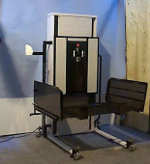 Wheelchairs are a powerful tool used to help those who have difficulty walking or getting around. There are many types of wheelchairs, including sports wheelchairs, manual wheelchairs, and electric wheelchairs. While incredibly useful, one common problem among wheelchair users is accessing areas that have staircases. One option to increase accessibility is to use a vertical platform lift.
Wheelchairs are a powerful tool used to help those who have difficulty walking or getting around. There are many types of wheelchairs, including sports wheelchairs, manual wheelchairs, and electric wheelchairs. While incredibly useful, one common problem among wheelchair users is accessing areas that have staircases. One option to increase accessibility is to use a vertical platform lift.
Vertical platform lifts are basically small elevators, but unlike a regular elevator, the unit is entirely self contained. Vertical platform lifts, which are also called porch lifts and wheelchair lifts, are placed next to the landing of a staircase and raise vertically to the top of the landing. Depending on the model, some porch lifts can raise up to 12 feet, which is rather high for a front porch.
Vertical platform lifts are similar to stair lifts, in that they are designed to be used by those who have difficulty using the stairs. However, unlike a stair lift, which only provides a chair or small platform to stand on, it is possible to drive a wheelchair directly onto the vertical platform lift. As a result, they can be used with manual wheelchairs, electric wheelchairs, and even mobility scooters, with most supporting over 500 pounds of weight.
Installing a wheelchair lift is usually very easy, but it requires a sturdy base that is capable of not only supporting the weight of the wheelchair lift, but also the people using it. The base should be made out of concrete or wood and it is very important to consider drainage as well. Proper drainage will prevent water from pooling up under the wheelchair lift, as well as keeping the area around it free from mud or pooled water. It is also important to consider roof water runoff, so it is important to have gutters installed above the wheelchair lift if it is to be installed under an overhang. Also, care should be taken to remove any limbs that may fall on the wheelchair lift during a storm.
Aside from a sturdy base, the only main requirement is that there is enough room next to the landing to install the wheelchair lift. This is because the platform of the wheelchair lift moves vertically from the ground to the landing and back down again, so it must be able to be placed next to the staircases landing. As a result, wheelchair lifts will often not work on interior staircases. In this case, a special platform stair lift is used, which uses a platform attached to a metal track running the length of the staircase to transport the wheelchair user. However, the exception to this rule is in commercial settings, such as schools and churches, where it is often possible to install the wheelchair lift directly next to the staircase’s landing.
Wheelchair lifts offer a very easy and cost effective way of making the home more accessible to wheelchair users, but many people still prefer to use a ramp. The main advantage of a wheelchair ramp is that it is usually considerably less expensive than a wheelchair lift, especially if you build it out of wood.
Choosing the Right Type of Mobility Vehicle Lift
Saturday, December 5th, 2009
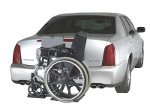 Vehicle Lifts are used to make it easier to transport a wheelchair or mobility scooter. When considering what type of vehicle lift to use, there are several factors that should be taken into account, including what type of mobility vehicle is being transported and what type of vehicle is being used. These factors will often help narrow down the options that are available to the wheelchair user, making it much simpler to select the right wheelchair lift.
Vehicle Lifts are used to make it easier to transport a wheelchair or mobility scooter. When considering what type of vehicle lift to use, there are several factors that should be taken into account, including what type of mobility vehicle is being transported and what type of vehicle is being used. These factors will often help narrow down the options that are available to the wheelchair user, making it much simpler to select the right wheelchair lift.
What Type of Mobility Vehicle is Being Transported
The type of mobility vehicle that is being transported is often the biggest factor that helps determine what type of vehicle lift to use. There are many different models of mobility vehicles, but they can usually be classified as manual wheelchairs, electric wheelchairs, and mobility scooters.
In the case of transporting a manual wheelchair, most people will simply fold it up and put it in their trunk. However, since manual wheelchairs can be rather heavy, sometimes lifting them into the back of the car can be difficult. Also, there is often simply not enough room in the car, so an external wheelchair lift is used. These are usually not motorized and attach to the hitch of a vehicle.
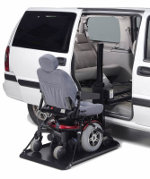 Of course, if you have a mobility scooter or an electric wheelchair, a manual wheelchair lift will not work. Instead, you would need to invest in a motorized wheelchair lift. In some cases, electric wheelchair carriers and mobility scooters carriers can be used interchangeably, but this is not always the case.
Of course, if you have a mobility scooter or an electric wheelchair, a manual wheelchair lift will not work. Instead, you would need to invest in a motorized wheelchair lift. In some cases, electric wheelchair carriers and mobility scooters carriers can be used interchangeably, but this is not always the case.
For example, often instead of a full platform, mobility scooter lifts will use a lift that has metal tracks, which are only large enough for the wheels of the scooter to fit into. When loading the scooter, the wheels will be driven into the tracks, which support the entire weight of the device. For three wheel scooters, the lift will have three tracks and for four wheeled scooters, there would be two tracks.
Some other lifts will have automatic hold down arms, which engage as the lift is being raised and hold the scooter in place without the need for tie-down straps. The automatic hold down arm works, because of the longer design of the mobility scooter, making contact with the floor portion where the use rests their feet. However, most electric wheelchairs will not work with this type of lift.
When in doubt, if the lift is labeled as an Universal Lift this means it will work with both electric wheelchairs and mobility scooters. Otherwise, it will often only work with one or the other.
What Type of Vehicle is Doing the Transporting
 The type of vehicle that will transporting the mobility vehicle is also important.
The type of vehicle that will transporting the mobility vehicle is also important.
For example, those that wished to use a passenger car have fewer options than those with a van or SUV. Typically, the only option would be a hitch mounted lift or a crane lift. The hitch mounted lift is simply inserted onto the vehicles hitch and either has its own battery pack or uses the vehicles power. Crane lifts are installed into the trunk of the car and simply hoist the wheelchair off the ground in the same manner a crane lifts a heavy load to the top of a building. One feature to look out for when shopping for crane lifts is Powered Rotation, which means the crane’s arm can be completely controlled electronically.
Those who have a SUV or van can also use the hitch mounted lift or the crane lift, but internal wheelchair lifts are also an option. These use a small platform that extends from the vehicle, allows the scooter or wheelchair to be driven onto the platform, then retracts, storing the wheelchair inside of the vehicle. These are most popular with vans, as by removing one of the rows of seats, the scooter can be stored directly behind the drives seat. In SUVs, internal lifts are used in the rear trunk area.
Those with trucks also have a few options and can of course use the crane or hitch mounted options described above. There are also several specially made truck lifts that are designed to lift the scooter off of the ground and into the bed of the pickup truck.
Where You Live or Where You Plan on Traveling to
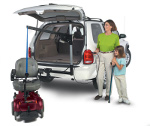 Yet another factor that helps determine what type of wheelchair lift is right, is where the person lives or where they plan on using the lift. For example, those who live in an area that gets a great deal of rain, snow, or other inclement weather, would probably want to go with a internal wheelchair lift. This way the wheelchair or scooter will be stored safely out of the weather.
Yet another factor that helps determine what type of wheelchair lift is right, is where the person lives or where they plan on using the lift. For example, those who live in an area that gets a great deal of rain, snow, or other inclement weather, would probably want to go with a internal wheelchair lift. This way the wheelchair or scooter will be stored safely out of the weather.
However, those who live in a more moderate climate would be able to use a hitch mounted wheelchair lift that stores the wheelchair outside of the vehicle. However, it is still usually recommended to invest in a cover for the wheelchair or scooter, to protect against sudden storms or road debris.
Increasing Wheelchair Accessibility: The Front Steps
Monday, November 23rd, 2009
For wheelchair users, making sure that all areas of a home is accessible is very important, not just to make getting around easy, but also to address safety concerns. In most cases, ensuring a home is wheelchair friendly starts with the front entrance.
Depending on how a home is set up, the front or side door usually presents the first and sometimes only hurdle to a wheelchair user. So, finding a way to safely and cost effectively bridge this gap is very important and largely depends on the type of door in the home.
Most homes have at least one or two steps separating around most entrances, which can present a very big obstacle to those who use wheelchairs.
Small Wheelchair Ramps
If there are only a few steps, installing a small ramp is sometimes the quickest, easiest, and least expensive way of ensuring wheelchair access.
Ramps come in a variety of sizes and designs, both made out of wood and metal. Since the length of a wheelchair ramp is directly proportional to the length of the staircase, the lower the staircase, the shorter the ramp.
If the staircase is only a few feet high, it is usually possible to install a very short ramp, which can be removed or repositioned as necessary. Often, folding metal ramps are used, which are also popular for use with larger vans. If the ramp does not fold, then it is usually made as a single piece, much like a large board of plywood, but much stronger and more rigid.
One of the main advantages of using a short semi-permanent ramp is cost, as these tend to be the least expensive to build or purchase. They can also be quickly removed as needed and typically don’t take up all that much space. However, these types of ramps only work on very short stairways.
For larger staircases, a much longer ramp is needed. Depending on space, this sometimes means creating a zig-zag design, rather than a straight ramp. Usually, as a result of how much longer of a ramp you would need for a larger staircase, installing the ramp on the front of the house is a necessity.
Large Wheelchair Ramps
Like the smaller ramps, it is possible to go with a metal or wooden design. The wooden design is popular, as the materials to build a wheelchair ramp are not very expensive, so if you know someone who is handy, building your own wheelchair ramp is often the best choice from a monetary standpoint. Metal wheelchair ramps are also available and come in sections, making it a modular wheelchair ramp. The number of sections varies by the height of the steps and installing the ramp is simply a matter of connecting the individual sections.
Wheelchair ramps are popular as they do not require any electricity to use and usually don’t have any moving parts, so there are few points that could fail. In most cases, providing the proper type of wood is used and faulty boards are replaced as needed, a wooden wheelchair ramp will last as long as needed.
However, wheelchair ramps do require that the user is able to move themselves along the ramp and depending on the height of the staircase, they can take up a great deal of yard space.
Wheelchair Lifts
Wheelchair lifts or, as they are typically referred to in the industry, vertical platform lifts, represent one of the easiest and safest ways of increasing staircase accessibility. For all intensive purposes, a vertical platform lift is simply a self-contained elevator. Unlike the type of elevators you would see inside of a building, wheelchair lifts do not require a large shaft in the home or much modification to the home. Instead, wheelchair lifts need only be placed next to the staircase landing on a strong surface made out of wood or concrete.
To use a wheelchair lift, the user simply drives their wheelchair onto its platform and activates the call buttons. The platform than lowers or rises the distance of the staircase. One of the advantages of a wheelchair lift is that it can be used easily and requires very little effort on the part of the wheelchair user or caretaker. Simply pushing a button is all it takes to make the stairs safer. Wheelchair lifts also do not take up much front yard space.
However, wheelchair lifts represent the most expensive option, costing significantly more than building your own wheelchair ramp.
How to Transport a Wheelchair
Monday, November 2nd, 2009
As a result of the ADA and other legislation, many of the areas a wheelchair user wishes to go are made accessible. There are of course exceptions to the rule, but the overwhelming majority of businesses in the United States are wheelchair accessible. As a result, the most difficult part of using a wheelchair in public is generally getting it where you need it to be or transporting the wheelchair.
There are a number of different methods to transport a wheelchair, but often the most effective means is to use a vehicle wheelchair lift. Without a vehicle wheelchair lift, however, it is often still possible to transport a wheelchair.
Transporting the Wheelchair in the Trunk or Backseat
 Depending on the type of wheelchair, it is sometimes possible to simply store the wheelchair in the trunk of the vehicle or even in the back seat. This is easiest with manual wheelchairs, which are designed to be folded up when not in use.
Depending on the type of wheelchair, it is sometimes possible to simply store the wheelchair in the trunk of the vehicle or even in the back seat. This is easiest with manual wheelchairs, which are designed to be folded up when not in use.
Some electric wheelchairs and mobility scooters are also designed to be transported easily without a wheelchair lift. These mobility vehicles are usually called travel wheelchairs or travel scooters and are made to be taken apart easily, with no one piece weighing too much for a person to safely lift into their trunk. One drawback to this type of electric power chair or scooter, however, is that in order to reduce weight, a number of features are removed that are in other standard electric wheelchairs.
Using a Van Ramp
 Another option for transporting a wheelchair is to use a ramp system. There are a number of metal folding ramps available, which are designed to be used with the side door of a van. These allow the wheelchair to be driven directly into the van or to be operated by someone standing next to the wheelchair.
Another option for transporting a wheelchair is to use a ramp system. There are a number of metal folding ramps available, which are designed to be used with the side door of a van. These allow the wheelchair to be driven directly into the van or to be operated by someone standing next to the wheelchair.
While it is possible to use a ramp with other types of vehicles, this option works best with vans that have had at least one row of seats removed.
Ramps offer a cost effective wheelchair transport solution, but do not work with all vehicles and unless someone is there to help position the ramp, they can be difficult to use.
Using a Wheelchair Lift
Wheelchair lifts are more expensive than using a ramp, but are much easier to use independently. There are a number of wheelchair lift designs, but they can be broken down into interior wheelchair lifts and exterior wheelchair lift.
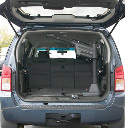 Interior wheelchair lifts are installed inside of the vehicle and store the wheelchair inside as well. There are a few different designs, but most either use a platform lift system or a crane lift system. The platform lift system allows the user to drive their wheelchair onto a small platform that extends from the vehicle. Then, once activated, the wheelchair lift will move the platform and wheelchair inside of the vehicle. You will often see this type of wheelchair lift in vans, but they can also be used in trucks and SUVs.
Interior wheelchair lifts are installed inside of the vehicle and store the wheelchair inside as well. There are a few different designs, but most either use a platform lift system or a crane lift system. The platform lift system allows the user to drive their wheelchair onto a small platform that extends from the vehicle. Then, once activated, the wheelchair lift will move the platform and wheelchair inside of the vehicle. You will often see this type of wheelchair lift in vans, but they can also be used in trucks and SUVs.
The other type of interior wheelchair lift is the crane lift, which is basically just a crane that attaches to the wheelchair and the raises it into the vehicle. Crane lifts can not be used with someone sitting on the wheelchair and it is sometimes necessary to partially disassemble the wheelchair before moving it into the vehicle.
One of the advantages of crane lifts is that they don’t take up much space, so they can be used in a car, where other wheelchair lifts would not work. A nice feature when shopping for a crane wheelchair lift is powered rotation, which means that the arm of the crane can be swiveled using a hand control. This makes it easier to swing the wheelchair into position.
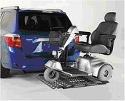 Exterior wheelchair lifts, on the other hand, almost always use a platform lift system, except unlike interior wheelchair lift, the wheelchair is stored outside of the vehicle. Exterior wheelchair lifts attach to the hitch of a vehicle, which means that they are very easy to install, don’t require modification to the vehicle, and do not take up any interior space.
Exterior wheelchair lifts, on the other hand, almost always use a platform lift system, except unlike interior wheelchair lift, the wheelchair is stored outside of the vehicle. Exterior wheelchair lifts attach to the hitch of a vehicle, which means that they are very easy to install, don’t require modification to the vehicle, and do not take up any interior space.
How to Install a Vertical Platform Lift
Friday, October 16th, 2009

The homeowner built their own gate for this porch lift.
Choosing the Right Location
Before ordering a vertical platform lift, it is important to ensure that you have a place where it can be installed in your home. These devices work by raising a platform straight up in the air to the top of a staircase, so must be placed directly next to the staircase landing. The placement is important, because when the platform of the wheelchair lift is completely raised, the user can drive their wheelchair directly from the landing onto the platform.
It is usually necessary to remove a section of the handrail from the landing. Some porch lifts offer a door that goes in place of the removed handrail, so it is not possible to drive or fall off the landing when the platform is not present. It is also possible to build your own door.
Preparing to Install
Wheelchair lifts require a solid base, which will be able to support both the weight of the lift and anyone that is using it. The best sort of base is one made out of concrete, but a wooden base will also suffice. For temporary installations, it is also sometimes possible to mount the wheelchair lift on a few 2 by 4′s, which are buried in the ground. However, this should only be used temporarily, while a concrete or permanent wooden base is being built.
In addition to providing adequate weight support, the platform should also have adequate drainage, so water does not pool under the lift when it rains. This isn’t usually a problem with wooden bases, but is common in concrete bases. If at all possible, a drain should be installed in the concrete base.
Another consideration is the way the water runs off of the roof, as most wheelchair lifts will be installed partially under the roof overhang. This means that gutters should be installed over the porch lift and they should be kept clean, to avoid water runoff.
Falling tree branches could also cause problems, so if there are any branches overhanging where the lift will be installed, they should be removed prior to installing the wheelchair lift.
An electrical outlet must also be located near the wheelchair lift.
Installing the Wheelchair Lift
Once the prep work is done, the actual installation usually goes very smoothly and quickly. Some wheelchair lifts do not require any assembly at all, but most come in a few pieces. However, even if there is some assembly required, it usually very simple.
After the lift itself has been assembled, it is necessary to move it onto its base. If the base is made out of concrete, it will be necessary to use anchor bolts drilled into the concrete. For wooden bases, it is simply a matter of screwing the bolts into the wood.
Once secured to the base, the wheelchair lift can simply be plugged in and it is ready to go.
Vertical Platform Lifts and Wheelchair Ramps
Thursday, September 24th, 2009
There are usually some areas with limited wheelchair accessibility that wheelchair users must face when away from home, but there is no reason that any area in your own home should not be wheelchair accessible. Yet, for many this is something that must be faced, with narrow doorways often being a problem.
Another, perhaps even more important obstacle, is the front staircases that adorns most homes. For many wheelchair users, the first step in making their home more wheelchair friendly is to find a way to easily use the front porch.
There are two ways that the front porch is usually made wheelchair accessible, namely by installing a wheelchair ramp or a wheelchair lift.
Wheelchair Ramps
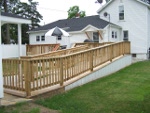 Wheelchair ramps are very common and are often built out of wood by the homeowner. There are a number of free wheelchair ramp plans, which can provide an easy way to increase accessibility. Going the wooden wheelchair ramp route is often the least expensive option and allows the homeowner to custom fit the wheelchair ramp to their yard.
Wheelchair ramps are very common and are often built out of wood by the homeowner. There are a number of free wheelchair ramp plans, which can provide an easy way to increase accessibility. Going the wooden wheelchair ramp route is often the least expensive option and allows the homeowner to custom fit the wheelchair ramp to their yard.
Another option is to use a prefabricated modular wheelchair ramp system. These systems are made out of metal and come in short sections, which are then securely bolted together. The height of the staircase, as well as how many bends are needed in the ramp, determine how many sections are needed. Many people prefer the shiny metal look of modular wheelchair ramps, which are also more weather resistant than wooden wheelchair ramps. However, they are a great deal more expensive than building your own wooden wheelchair ramp.
One disadvantage of using a wheelchair ramp is that they can take up a great deal of space in the yard. This depends on how high the front porch is, with a higher front porch requiring a longer wheelchair ramp. In areas where there is a very small front yard, this might mean that most of the space will be taken up by the wheelchair ramp.
Vertical Platform Lifts
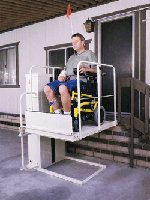 Wheelchair lifts provide a much more low profile solution and are basically mini-elevators. The technical name for a wheelchair lift is a vertical platform lift, which describes how these devices work. The wheelchair lift is placed next to the landing of the front porch, with a platform rising vertically from the ground to the front porch.
Wheelchair lifts provide a much more low profile solution and are basically mini-elevators. The technical name for a wheelchair lift is a vertical platform lift, which describes how these devices work. The wheelchair lift is placed next to the landing of the front porch, with a platform rising vertically from the ground to the front porch.
While vertical platform lifts are similar in concept to an elevator, the entire unit is self-contained, so with the exception of providing a sturdy base for the lift, there is little modification to the structure of the home. The base can be made of wood or concrete, with proper drainage being very important. When considering the placement of the wheelchair lift, it is important to take into account how water drains off the roof, because you do not want it draining directly onto the lift, even though wheelchair lifts are weather resistant.
The main advantage of a vertical platform lift, other than the small amount of space it takes up, is that it provides a virtually effortless means of entering the house. The user need only drive their wheelchair onto the platform and push a button, with the lift doing the rest of the work.
From a cost perspective, vertical platform lifts do usually cost considerably more than wooden wheelchair ramps. However, with the high price of modular metal wheelchair ramps, there is not always as large of a price difference between wheelchair lifts and metal wheelchair ramps.
Vertical Platform Lifts and Inclined Platform Lifts
Tuesday, September 22nd, 2009
For those who use electric wheelchairs or other types of mobility vehicles, ensuring that the home is wheelchair friendly is incredibly important. There are many things that can decrease accessibility, such as narrow doors or raised door frames, but of all areas in a home, often the front steps present the largest hurdle.
Since building a wheelchair ramp takes up a lot of the front yard, with the same being true of modular metal wheelchair ramps, which are more expensive, many wheelchair users turn to vertical platform lifts to increase accessibility.
How Vertical Platform Lifts Work
 Vertical platform lifts are often called wheelchair lifts or porch lifts, as they are most often seen on the front porch of a home. In many ways, vertical platform lifts are very similar to elevators, however unlike an elevator, a vertical platform lift is a completely self-contained unit. The lifting system, lifting shaft, and lifting platform are basically a single unit, which can simply be placed next to a staircase, typically without having to preform any major modification to the home.
Vertical platform lifts are often called wheelchair lifts or porch lifts, as they are most often seen on the front porch of a home. In many ways, vertical platform lifts are very similar to elevators, however unlike an elevator, a vertical platform lift is a completely self-contained unit. The lifting system, lifting shaft, and lifting platform are basically a single unit, which can simply be placed next to a staircase, typically without having to preform any major modification to the home.
Porch lifts work by raising a metal platform from the ground to the staircase landing. The porch lift is placed directly next to the staircase landing and rises vertically. Most have a base lifting height of about 4 feet, which can then be upgraded as needed.
The shaft of the wheelchair lift is designed with stability and weight capacity in mind. It is not uncommon for a wheelchair lift to support more than 700 pounds, so multiple people can use it at once, or the device can be used to make bringing groceries or furniture into the home.
The platform of most wheelchair lifts is surrounded to prevent rolling off of the lift while it is in motion. Many also include locking gates for the top landing, which can greatly reduce the risk of a fall. These types of safety gates and doors are often a requirement for commercial wheelchair lifts.
Using a Wheelchair Lift Indoors
As a result of how these devices are used, vertical platform lifts work incredibly well on the front porch of a home, but will not work with many residential indoor staircases. The exception being schools, churches, and other commercial buildings, where vertical platform lifts are often well suited for indoor use. Whether the wheelchair lift can be used indoors depends on if the lift can be placed next to the landing and rise high enough to reach it. Most wheelchair lifts have a maximum lifting height of 12 feet.
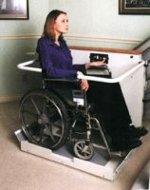 Instead, for indoor use, an inclined platform lift is often a better choice to increase wheelchair accessibility. Inclined platform lifts use a metal track that is attached to the wall of the staircase, running its entire distance. A car, which consists of a large platform and is surrounded by a protective gate, moves along the track, carrying a single wheelchair user.
Instead, for indoor use, an inclined platform lift is often a better choice to increase wheelchair accessibility. Inclined platform lifts use a metal track that is attached to the wall of the staircase, running its entire distance. A car, which consists of a large platform and is surrounded by a protective gate, moves along the track, carrying a single wheelchair user.
Inclined platform lifts can be pretty large though, so on narrower staircases, they might not work. However, when not in use, the inclined platform lift can be folded, so the staircase can still be used.
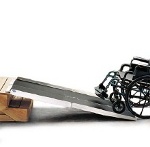 For very short staircases, of only a few steps, a simple metal ramp is the easiest and least expensive option. These come in a variety of designs, but are usually between 3′ and 6′ long. The ramp, which is made out of lightweight metal and usually has a non-skid textured backing, is simply placed onto the landing of the staircase, with some offering lightweight clamps that help hold the ramp in place. The wheelchair user can then drive up or down the ramp, which can be set up or removed in minutes.
For very short staircases, of only a few steps, a simple metal ramp is the easiest and least expensive option. These come in a variety of designs, but are usually between 3′ and 6′ long. The ramp, which is made out of lightweight metal and usually has a non-skid textured backing, is simply placed onto the landing of the staircase, with some offering lightweight clamps that help hold the ramp in place. The wheelchair user can then drive up or down the ramp, which can be set up or removed in minutes.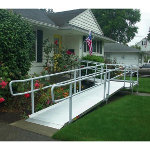 For larger staircases, a much larger wheelchair ramp is required. These often are custom built out of wood, with many free wheelchair ramp plans available online. Wooden wheelchair ramps are usually a fairly cost effective option and can be built by most handymen. It is also usually possible to hire most carpenters to build a wooden wheelchair ramp.
For larger staircases, a much larger wheelchair ramp is required. These often are custom built out of wood, with many free wheelchair ramp plans available online. Wooden wheelchair ramps are usually a fairly cost effective option and can be built by most handymen. It is also usually possible to hire most carpenters to build a wooden wheelchair ramp. 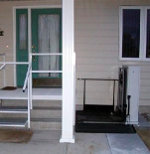 Wheelchair lifts are also a popular choice for those who use mobility scooters and electric wheelchairs, with these devices being very similar to an elevator in the way they work. The wheelchair lift, which is referred to as a vertical platform lift in the home medical industry, is placed next to the landing of the staircase, raising and lowering the wheelchair user on a metal platform.
Wheelchair lifts are also a popular choice for those who use mobility scooters and electric wheelchairs, with these devices being very similar to an elevator in the way they work. The wheelchair lift, which is referred to as a vertical platform lift in the home medical industry, is placed next to the landing of the staircase, raising and lowering the wheelchair user on a metal platform.